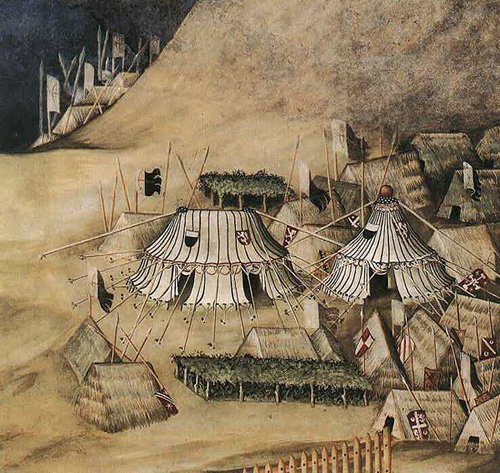The
alternative is the ever-popular Germanic adoption of the Hussite
Wagon-fort.

This
image is the perfect model of an Imperial camp, as should
be portrayed by our group. Two styles of wagons are seen here.
The outer-most 'wall' of the wagon-fort is made up of wagons
housing small canon, protected by sliding wooden doors. The
canon on the inside is set to a pivoting stand, so that it
can rotate 360°.
A
gate created of timber and woven wattle branches serves as
the entrance portal. Guards are on-station here at all times.
When admittance into the camp is permitted, the brace is lifted,
much like after paying a toll-booth.
Note
behind the gate, past the first line of wagons, is the Wachtmeister
(master of the watch) with his baton. This was the man in
charge of the entire camp and feared by all.
Also
of a strange note is the seeming lack of latrines, as one
man, in the foreground with his back to us, is relieving himself
just beyond the cannon-wagon wall! Perhaps this was another
deterrent to attackers, though an obvious (to us) health-hazard
as well.

A Burgundian encampment scene. Note the nobles lounge in the
tent while their retainers set the tent up and secure guy-lines. Of note is that the personal possessions are already
inside.

This
second camp is another interesting Imperial camp. Note most
Imperial tents have two signets identifying their owners.
The poles extend beyond the canvas, being capped with decorative
tops. The seems are reinforced against the weather by a water-sealant
paint, giving an indication to the size of the tent as each
area between the stripes are an entire width of the bolt of
material. The straw huts are an interesting sight. Also notable
are the guy-lines at the bottom of the walls. |